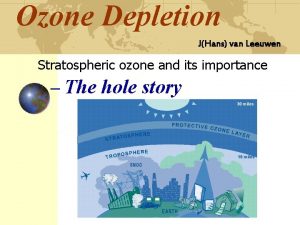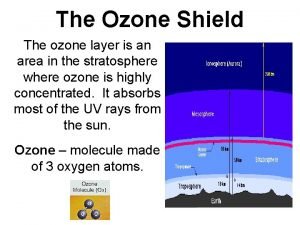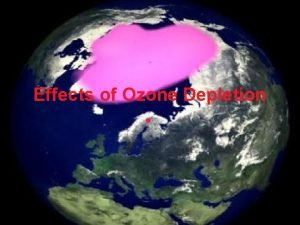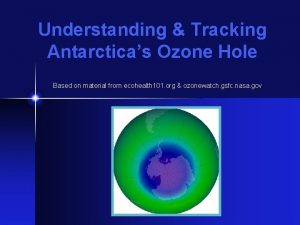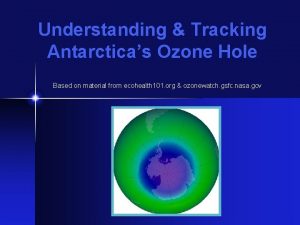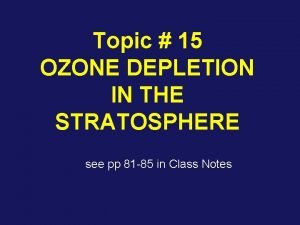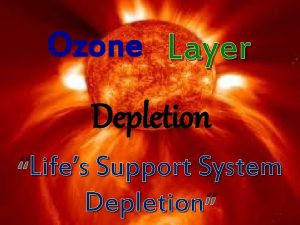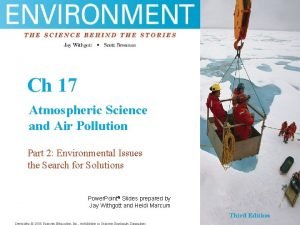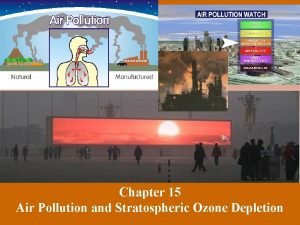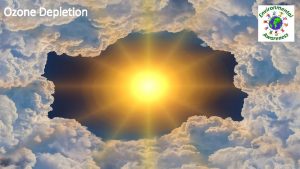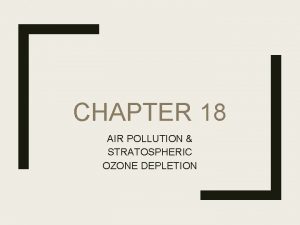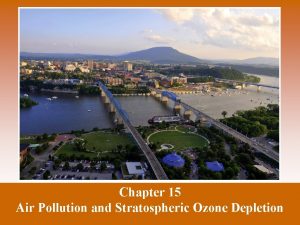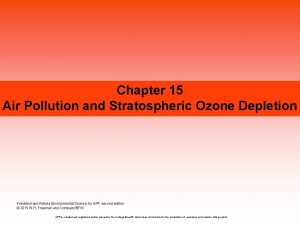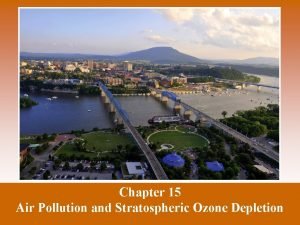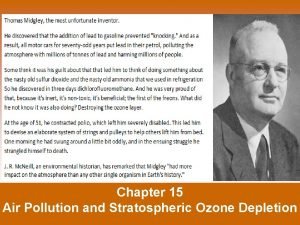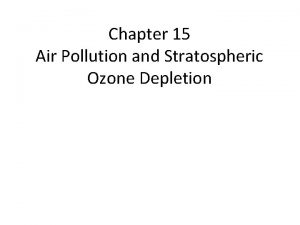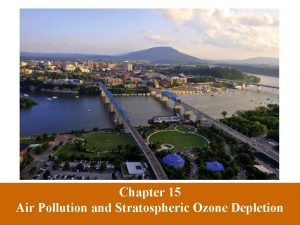Chapter 15 Air Pollution and Stratospheric Ozone Depletion










- Slides: 10

Chapter 15 Air Pollution and Stratospheric Ozone Depletion

Stratospheric Ozone © The stratospheric ozone layer exists roughly 45 -60 kilometers above the Earth. © Ozone has the ability to absorb ultraviolet radiation and protect life on Earth.

Not needed in notes Formation and Breakdown of Ozone © First, UV-C radiation breaks the bonds holding together the oxygen molecule O 2, leaving two free oxygen atoms: O 2 + UV-C -> 2 O © Sometimes the free oxygen atoms result in ozone: O + O 2 -> O 3 © Ozone is broken down into O 2 and free oxygen atoms when it absorbs both UV-C and UV-B ultraviolet light: O 3 + UV-B or UV-C -> O + O 2

The Chemistry of Ozone and Photochemical Smog Formation Tropospheric ozone and photochemical smog formation. (a) In the absence of VOCs, ozone will form during the daylight hours. (b) After sunset, the ozone will break down. (c) In the presence of VOCs, ozone will form during the daylight hours. The VOCs combine with nitrogen oxides to form photochemical oxidants, which reduce the amount of ozone that will break down later and contribute to prolonged periods of s e t photochemical smog. no e n t o N n i d e

Not needed in notes Anthropogenic Contributions to Ozone Destruction © Certain chemicals can break down ozone, particularly chlorine. © The major source of chlorine in the stratosphere is a compound known as chlorofluorocarbons (CFCs) © CFCs are used in refrigeration and air conditioning, as propellants in aerosol cans and as “blowing agents” to inject air into foam products like Styrofoam. © © When CFCs are released into the troposphere they make their way to the stratosphere. The ultraviolet radiation present has enough energy to break the bond connecting chlorine to the CFC molecule… which can then break apart the ozone molecules.

Not needed in notes The Chemistry of Ozone Destruction © First, chlorine breaks ozone’s bonds and pulls off one atom of oxygen, forming a chlorine monoxide molecule and O 2: O 3 + Cl -> Cl. O + O 2 © Next, a free oxygen atoms pulls the oxygen atom from Cl. O, liberating the chlorine and creating one oxygen molecule: Cl. O + O -> Cl + O 2 © One chlorine atom can catalyze the breakdown of as many as 100, 000 ozone CLICK HERE if animation doesn’t load molecules before it leaves the stratosphere.

Depletion of the Ozone Layer © Global Ozone concentrations decreased by more than 10%. © Depletion was greatest at the poles (North AND South). © Decreased stratospheric ozone has increased the amount of UV-B radiation that reaches the surface of Earth. Why?

Regulations The movement of large polluted air masses across the Pacific Ocean into the northern United States is a reason why collaborative international air quality legislation would be useful. (see articles below) Air Pollution from Asia Affecting World's Weather http: //www. sciencedaily. com/releases/2014/01/140121130034. htm Science. Daily: Jan. 21, 2014 http: //www. nature. com/scitable/blog/green-science/the_impact_of_asian_air January 23, 2014 | by: Samantha Jakuboski (high school student) • In 1987, 24 nations signed the Montreal Protocol which Montreal Protocol was an international agreement that allowed for a reduction, and eventual elimination, of CFC production and use (at least within participating countries).

Indoor Air Pollutants The World Health Organization estimates that indoor air pollution is responsible for more than 1. 6 million deaths annually worldwide, and that 56 percent of those deaths occur among children less than 5 years of age. Ninety percent of deaths attributable to indoor air pollution are in developing countries. In developing countries: © Wood, animal manure or coal used for cooking and heating in homes. In developed countries: ©Carbon Monoxide ©Asbestos, Radon, Lead, VOCs

Radon EPA: January is National Radon Action Month: Test for Dangerous Radon Gas http: //yosemite. epa. gov/opa/admpress. nsf/0/96 B 112 F 9 CB 92 EDC 48525797 C 0063 D 40 E Although homeowners cannot see, taste or smell radon, this toxic gas constitutes a serious public health risk. Radon exposure is ranked second only to smoking as a cause of lung cancer. Approximately 21, 000 Americans lives are claimed each year from lung cancer due to radon. One in 15 homes contains high levels of radon. The American Lung Association, Centers for Disease Control and National Cancer Institute are in agreement that radon is a worldwide health problem and encourage radon testing during the "National Radon Action Month". The Environmental Protection Agency (EPA) has responded to this risk with National Radon Action Month. Swat Environmental is giving out FREE Radon Test Kits to homeowners, visit http: //www. SWAT-Radon. com or call 1800 -420 -3881 to order your kit. You can also go to Radon. Month. org for more information. Potential radon exposure in the United States. Depending on the underlying bedrock and soils, the potential for exposure to radon exists in houses in certain parts of the United States.
